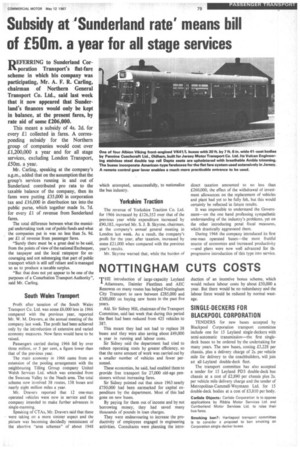NOTTINGHAM CUTS COSTS
Page 81

If you've noticed an error in this article please click here to report it so we can fix it.
THE introduction of large-capacity Leyland Atlanteans, Daimler Fleetlines and AEC Renowns on many routes has helped Nottingham City Transport to save between £285,000 and £300,000 on buying new buses in the past five years.
Ald. Sir Sidney Hill, chairman of the Transport Committee, said last week that during this period the fleet had been reduced from 425 vehicles to 387.
This meant they had not had to replace 38 buses and they were also saving about £49,000 a year in running and labour costs.
Sir Sidney said the department had tried to reduce operating costs by greater efficiency, so that the same amount of work was carried out by a smaller number of vehicles and fewer personnel.
These economies, he said, had enabled them to provide free transport for 27,000 old-age pensioners without increasing fares.
Sir Sidney pointed out that since 1963 nearly £750.000 had been earmarked for capital expenditure by the department. Most of this had gone on new buses.
By paying for them out of income and by not borrowing money, they had saved many thousands of pounds in loan charges.
They were endeavouring to increase the productivity of employees engaged in engineering activities. Consultants were planning the intro
duction of an incentive bonus scheme, which would reduce labour costs by about £50,000 a year. But there would be no redundancy and the labour force would be reduced by normal wastage.
















































































































































































































































